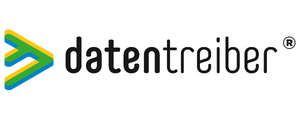
Data Strategy Designkit Canvas
The Data Strategy Designkit Canvas provides you with an overview of the Datentreiber Data Strategy Designkit tools. It also shows you the connections between the canvas templates and how they interact with each other. Using the Data Strategy Designkit Canvas you can plan your data strategy projects and document the current status.
We drive your business forward.
What Is the Data Strategy Designkit Canvas?
The Data Strategy Designkit Canvas is a planning tool for data strategy projects. It provides a structured overview of the Data Strategy Designkit’s tools by classifying them into three categories:
- Data: tools like the Data Strategy Canvas deal with technical and analytical questions related to data-driven business models and processes.
- Strategy: tools like the Value Chain Canvas consider the economical and functional part of data projects and analytical solutions.
- Design: tools like the Customer Touchpoints Canvas enable you to take on the user and customer perspective.
Furthermore, the detailed view of the canvas shows how the canvas tools are linked with each other and provides support by demonstrating how the interaction of the canvas works.
The Data Strategy Designkit Canvas is available for free under a Creative Commons license: you may use and modify the canvas as long as you cite Datentreiber in particular as the source.
We drive your business forward.

We drive your business forward.
How Do I Use the Data Strategy Designkit Canvas?
The Data Strategy Designkit is a collection of visual collaboration tools supporting the design process of successful data strategies in interdisciplinary teams. The corresponding canvas provides you with an overview of the available tools. Use this canvas to:
- Find out how you can combine the tools.
- Plan how and when you use which tool.
- Document the current state of your project.
For more information, see Data Strategy Design.
Start
Step 1 of 6
The Data Strategy Designkit provides you with an overview of the 12 tools (canvas) available for designing successful data strategies. It classifies the tools into three categories:
- Data: these tools cover the analytical and technical part of data-driven business models, the required data sources as well as management of those. The focus here is on the Data Strategy Canvas.
- Strategy: in the center of this category is the Business Model / Case Canvas and the questions regarding the economical and financial aspects of data-driven business models.
- Design: the user respectively the customer and their functional as well as personal needs are the focus in the third category. Here the Analytics Use Case Canvas forms the center.
Step 1 of 6
Combined, the tools ensure that three critical factors for innovation are met:
- Feasibility regarding technology and analytics as well as the availability of the required data
- Viability regarding costs and benefits
- Desirability regarding the customers’ and users’ perspective
Furthermore, the tools can be assigned to four main activities:
- Analyze: to better understand the current circumstances.
- Prioritize: to evaluate ideas, proposals, options, etc.
- Conceptualize: to design new solutions, business models, projects, etc.
- Concretize: to clarify the details, the approach, and more aspects.
Like it’s true for physical tools: the Designkit tools can be used for other tasks in a flexible way as well.
Step 2 of 6
Process
First, you need to be aware of what you would like to achieve: to design a new data-driven product, to optimize your business processes in a data-driven way, to convert your company to a data-driven business model? Subsequently think about what you need to analyze, prioritize, conceptualize as well as concretize and which tools are suitable for doing so. On top of that, you need to put in some thoughts regarding your actual starting point because this also defines the starting point on the Data Strategy Designkit Canvas.
Based on this information you can draft a workflow on the canvas. This workflow defines which tool will be used for which task. Datentreiber is collecting typical patterns regarding this workflow in a Designguide. A common approach for a data-driven optimization of your business model is for example:
- You analyze the business model with the Business Model / Case Canvas to focus on possible areas of application for example the marketing and sales channels.
- You draft customer journeys with the Customer Touchpoints Canvas and identify possible analytical solutions to optimize them.
- You sort solution proposals according to their analytical maturity using the Analytics Maturity Canvas and select the solutions with the next lowest level of complexity.
- You prioritize the remaining solutions according to their cost-benefit potential using the Priority Matrix.
- …
Step 3 of 6
Planning
According to the planned approach, you place the red cards with the numbers 1 to n on or beside the respective tools (respectively their pictograms) on the Data Strategy Designkit Canvas. Alternatively, you can note down on the red cards what you want to achieve by working with this tool, for example, “1. Focus on application area” or “4. Prioritize solutions”.
Step 4 of 6
Documentation
You document the current state on the canvas during the data strategy project by replacing the red cards with green ones as soon as you have conducted the respective step. Again, note down the number, if necessary the purpose and in particular the last date in case there is more than one version existing. If you still work on one step use a yellow card instead. Should during the project the situation arise that you need to change the order of the steps, just adjust the plan accordingly and place new red cards onto the canvas. Use white notes to make notes of important findings, tasks to be done, open questions, critical assumptions, etc.
Step 5 of 6
Combinations
The canvas supports you by visualizing the connections between the tools and how information (cards, notes, etc.) is passed from one tool to another one and the other way round. Accordingly, you find respective arrows between the two tools. These arrows are numbered and colored. They are located at the corners of the involved tools. Using the business model and data strategy as an example the graphical elements can be explained as follows:
- The numbers show the order: you start with the Business Model / Case Canvas and then transfer the information to the Data Strategy canvas. Next, you go on working with the Data Strategy Canvas and finally transfer the results back to the Business Model / Case Canvas.
- The fields which contain the relevant information are marked in the pictograms. For example, in the Business Model / Case Canvas, precisely in the fields for relationships, benefits and (key) activities there are use cases for data-driven solutions respectively products which can be transferred to the Utilization field on the Data Strategy canvas.
- the color of the arrows shows how to transfer the information. On the lower end of the Data Strategy Designkit Canvas there is a legend explaining the possible operations. When transferring from the Data Strategy Canvas to the Business Model / Case Canvas you should for example put the information coming from the fields Tools, People and Partners to the fields Ressources and Partnerships and sort them accordingly.
Important: the Data Strategy Designkit Canvas only shows a few of the many possible combinations. Depending on the purpose and situation, the tools can be arbitrarily combined and the information to focus, sort, generalize, and specify is transferred accordingly as well.
Step 6 of 6
Operations
The possible operations to transfer information from one canvas to another one are:
- Focus: you select one or a few cards out of a list of cards (ideas, solutions, proposals, etc.) and transfer only those from one canvas to another.
- Sort: you copy the cards and sort them on the second canvas according to the given structure on it.
- Generalize: you summarize, simplify or generalize, and place only the summary on the other canvas.
- Specify: you specify a card, by creating several cards with details and respectively place those on the other canvas.
We drive your business forward.
Where Can I Find More Information?
Here you can find further documentation:
Hit the sweetspot with your data strategy (Blog)
Data Thinker Group (LinkedIn)
We drive your business forward.
Como começar?
Workshops

Conheça nosso Método de Design de Estratégia de Dados em nossos workshops:
- Para iniciantes: Data Strategy & Culture
- Para entusiastas de dados: Data Design Thinking
- Para designers avançados: Data Business Consulting
Outras Referências

Aqui você pode encontrar outros Canvas e informações sobre o Design da Estratégia de Dados:
Termos de licença

Você pode:
Compartilhar — copiar e redistribuir o Canvas em qualquer meio ou formato
Adaptar — mudar, transformar e construir sobre o Canvas para qualquer finalidade, mesmo comercialmente.
Nos seguintes termos:
Atribuição
Compartilha-Igual
We drive your business forward.
Subscribe to our newsletter:
Receive all relevant blog articles, new seminar dates, special conference offers and much more conveniently by email. As a welcome gift, we will send you a link to download our Datentreiber design book (in German) and, for a short time, the article ” Data Thinking: mehr Wert aus Daten” in PDF form after your registration.
By clicking ‘Subscribe to our newsletter’ you agree that we process your information in accordance with our privacy policy.


